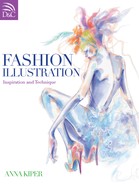FACES
FRONT FACE
In both realistic or stylized illustrations, the location of the main facial features should remain as close as possible to accurate anatomical proportions.
The eyes are in the middle of the face, one eye distance apart. The tip of the nose is located halfway between the eye level and chin on the center front line. Divide the lowest quarter of the face into three equal sections. The lowest section represents the chin area and the mouth is between the top and middle sections. The distance between the eyebrows and the top of the head is also divided into three equal sections. The top section represents the hair line.

3⁄4 FACE
The center front line of the 3⁄4 face is shifted according to the degree of the turn. Front face proportions remain the same on the side of the face closest to the viewer. The far side of the face is foreshortened. The length of the foreshortened eye should be reduced. The far corner of the foreshortened side of the mouth should be brought closer to the center front line. The bridge of the nose is more pronounced and the far nostril is barely visible.

PROFILE
In profile view, the oval shape of the head is slightly tilted and the forehead and bridge of the nose become part of the outline contour of the face. The mouth and chin are placed on an angle for a more feminine look. The profile eye is severely foreshortened, and the iris is oval shaped and sits inside the lids. Jaw and neck lines start at the chin as one, and split as the upper line curves to the ear and the lower line forms the neck outline. Place a strong shadow underneath the chin.

UP & DOWN FACES
For up-turned views, foreshorten the length of the face by curving up the chin line. The eye level is raised, and the bridge of the nose is foreshortened with a strong emphasis on the mouth and chin. This is an excellent view for big collars and necklaces, due to the elongated neck.


For down-turned views, slightly stretch the head oval and bring the eye level down. The chin covers most of the neck, while the bridge of the nose is elongated, and the top lip becomes a thin line. Emphasis is on the forehead and hair.


SHADING FACES
Faces do not need excessive shading. There are a few crucial areas where the shadows must be placed: around the eyes, next to the bridge of the nose, around the temples, and under the chin. Cheekbones should be emphasized with light shading,

Touches of shading are normally placed around and under the tip of the nose, emphasizing its dimensions. The upper lip is always darker than the lower one and a smear of shadow can be placed under the bottom lip with a bright highlight on top of it.
ILLUSTRATING HATS
Hats sit on the crown of the head. Brims wrap securely around the head and often cover the forehead and eyebrows. This can create a need for more intense shading of the face.

DRAWING HAIR
Treat hair as a combination of simple shapes. Each shape should have highlights, mid-tones, and shadows to make it look 3-dimensional. Different line qualities can convey a variety of hair types and styles.

THE FACE COLOURED IN STAGES
After achieving the detailed outline of the face (step 1), choose a skin tone colour to emphasize all shaded areas of the face: temples, the eye area, and under the cheekbones, chin, and mouth. Leave highlights on the forehead, bridge, and tip of the nose (step 2). Then add dimension and texture to hair and accessories (step 3).

An exciting variety of skin tones are available in any marker brand. Cooler or warmer shades can be selected for any skin tone variations of any ethnic group. Along with colour differences, specific ethnic features can be emphasized: higher cheek-bones, broader noses, narrow elongated eyes, and fuller lips (opposite page).
SKIN TONES

